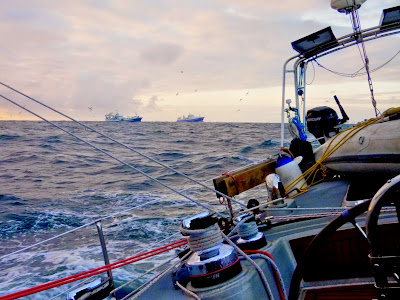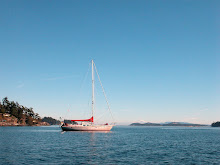The swell made it impossible to anchor off Bakkagerdi, the small town in Borgarfjordur so we moved over to the east side of the fjord and tucked in behind Hafnarholmi peninsula. It took two attempts to get our anchor to set in the rocky bottom and a local boat came out to watch, probably wondering why we weren’t coming into the small fishing harbour.
Puffin Landing , Hafnarholmi Peninsula
The peninsula was full of nesting puffins and kittiwakes. We could see people with telephoto lenses waiting patiently on the well placed viewing platforms for the perfect shot, even though it was getting late. In the morning we went ashore to make our own attempt at photographing the puffins. When we took the dinghy into the fishing harbor, we realized its tight entrance was deceiving and there was actually plenty of space for Snow Dragon. However, by being at anchor we had a better view of the fjord and were happy with our decision.
Puffins, Hafnarholmi peninsula
To avoid getting swept along with a tour bus group that had made a quick stop to check out the bird reserve, we went over to a less popular platform where the kittiwakes were nesting with their adorable fuzzy chicks. While the kittiwakes were dozing in between feeding their chicks pre-chewed food, the puffins were busy catching fish to feed their young. Returning with multiple fish hanging out of their beaks and pausing outside their burrows long enough to dry off before disappearing inside.
Road Out Of Bakkagerdi

Midnight Sun
An hour into Krystina’s watch, she looked out of the pilothouse window and saw a humpback whale fluke. She turned off the engine and let Snow Dragon drift to give the whales the choice of coming over to see us. Frances had just gotten to sleep but didn’t mind being woken up once she went on deck and saw two humpbacks approaching us. For 30 minuets they stayed closed to us, occasionally fluking and disappearing then reappearing on the opposite side. We had been cursing the lack of sailing wind but the calm made it ideal conditions for stopping to watch the humpbacks searching for food, not a bad way to start the day.
Humpback Whales Alongside Snow Dragon






























